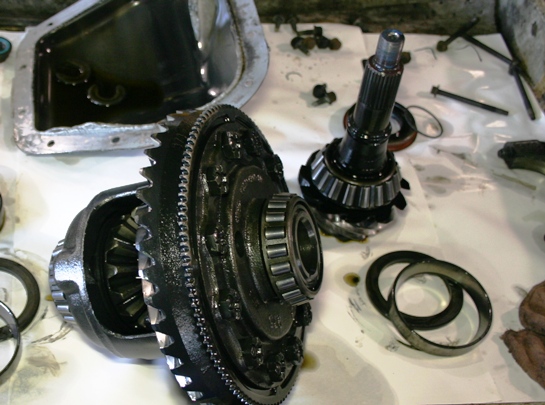Removing Differential Carrier and Pinion Bearings
March 28, 2012 1:11 pm Differential© DenLorsTools.com Summary: Article covering different methods of how to remove carrier and pinion bearings after the carrier and pinion have been taken out of the housing.
Most methods of removing differential bearings result in the bearing not being re-usable. This is OK if you’re planning on replacing it with a new bearing. However what if you need to pull a brand new bearing back off to install a different shim? Pulling a brand new pinion bearing back off to install a different shim may need to be done to achieve a different pinion depth.
Cut Off Tool
Many auto technicians will us a cut-off tool to remove old differential bearings. This is fairly quick and easy aside from all the flying debris from metal and pieces of the itchy cut-off wheel material. The airborne material caused by this method is harmful to breathe and may also end up in someone’s eye! Also the carrier or pinion may be weakened if the cut is made too far. A hairline cut may lead to a stress crack in time.
Air Chisel
Like the cut-off tool, most techs already have an air chisel (aka air hammer) in their tool box. However, an air chisel may not work to drive an old pressed bearing off of a carrier or pinion. The gears usually prevent adequate access.
Bearing Splitter
A bearing splitter is typically what is recommended by most tool manufacturers. Although, they are hard to position behind the bearing race since they are always pressed completely flush. If just the bearing cage is pulled, rollers will come out as dangerous projectiles. Then the race is still remaining to be dealt with. Sometimes the splitter can be tightened enough to grab the bearing assembly without it slipping. Not a hundred percent of the time and the bearing is always destroyed.
Bearing Puller
The A123 bearing puller pictured above works like a power steering pulley puller. First the race is put onto the bearing. Then the bearing puller is put onto the race. Adjustments are made to the threaded collars on the tool and then the clam shells put on. A little movement is all that is needed. The retaining ring is placed over the clam shell and tool assembly. It’s important to choose the correct size clam shells and orient them correctly. Never force the retainer on. If it has to be forced something is not right. Once the tool is set up correctly, it can remove bearings safely and intact. This eliminates harmful airborne material and also allows the rear pinion bearing to be removed without damaging it when a shim needs to be changed. See the video below for a quick demonstration of the more expensive version of this tool that works exactly the same.
